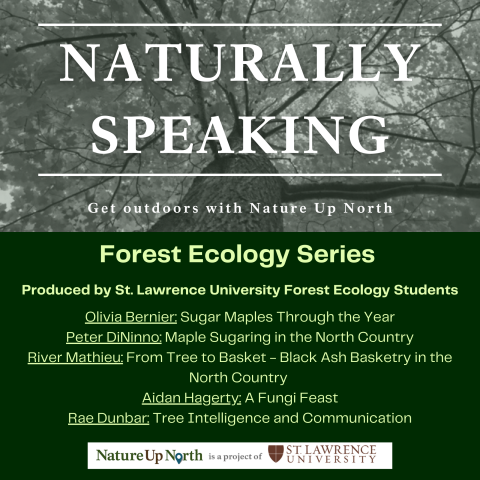
Kayla Edmunds
Naturally Speaking is back for Season 2, kicking off with a mini-series from St. Lawrence University Forest Ecology students! With this short overview we’ll introduce the five upcoming podcasts, where students explore a variety of different topics pertaining to North Country forests and trees. Maple sugaring, emerald ash borer, edible fungus, and tree communication are all on the table. This is a series sure to have something for everybody!
Olivia (00:00):
Sugar maples. The tree responsible for that liquid gold called maple syrup.
Rae (00:04):
But this web holds more mysteries than just nutrient passing.
River (00:08):
In doing so, emerald ash borer has the potential to kill 100% of the ash trees in a given area
Aidan (00:14):
Before realizing I was gonna need to enlist some help to get the chicken out of the tree.
Kayla (00:48):
Welcome back North Country listeners. You may have noticed that Naturally Speaking has been on a bit of a hiatus, but we're excited to bring you a short series from St. Lawrence University Forest Ecology students. The podcasts that we'll be releasing over the next month and a half truly run the gamut of topics, covering the sugar mapling process, the importance of black ash trees in the Akwesasne community and the threat of EAB, edible fungi, and how trees talk to each other. Today I'll just be giving a short overview of each podcast so you know what to expect when you tune. My name's Kayla, I'll be your host for the short intro podcast to the podcasts, thanks for listening. Be on the lookout for the first podcast on sugar maples soon, it's peak sugaring season, and the perfect time to learn. From Olivia you can look forward to following sugar maples through the four seasons
Olivia (01:38):
To help you understand why sugar maples are so important and why their declining numbers are so concerning. I'm going to take you through how a sugar maple tree experiences the four seasons, and the role they serve to the ecological community during each season. But first, let's take a minute to identify a sugar maple.
Kayla (02:01):
Then learn about how one local sugarer got into the business. As Peter talks with John Newman of NewmanZone maple about the ups and downs of sugaring and how time might change what we know about the maple sugaring season.
Peter (02:16):
The sound of rusting leaves is a sound I'm sure all of us here in the north country know well, but the trees that produce these leaves also produce an important cash crop, sugar maples scientific name Acer saccharum produce sap that is boiled down to make the delicious breakfast condiment maple syrup.
Kayla (02:34):
Moving away from maple trees, River takes us on a journey to Akwesasne through a conversation with Angello Johnson, a Mohawk basket maker. There they discuss the importance of the black ash tree to the tradition of basket making and the risk that black ash trees face from emerald ash borers in the region.
River (02:52):
New York state is home to many tree species. The North Country itself has a diverse variety with deep and expansive forests throughout the region. In the lowlands of the North Country, where water flows downward and stagnates live forested wetlands home to a lesser known tree species. Black ash is a slow growing species of ash tree that grows in these areas. The tree itself is culturally important to many indigenous and first nation groups in what is now Eastern North America and the Great Lakes region
Kayla (03:24):
Coming in mid April, we'll learn about the fun-guys that grow on trees and throughout the forest from Aidan, as he tells stories of
Aidan (03:31):
Bizarre and vibrant birds that grow from trees, investment opportunities in your backyard. And I might try and convince you to try out a new diet
Kayla (03:40):
And finally, to cap it all off, how do the trees we'll have talked about in these first four podcasts communicate? Do they talk like humans? Not quite, but Rae covers this in a conversation on mycology and more with St. Lawrence University, General Biology Manager, Claire Burkum. If the term wood wide web sounds intriguing, you definitely don't want to miss this podcast.
Rae (04:02):
As you walk through the forest of the North Country, it's hard to ignore the towering trees, motionless, quiet objects of the forest, but perhaps there are more to trees than meets the eye.
Kayla (04:16):
Thanks again for tuning in. We hope you're as excited for this mini series, as we are remember to like, and follow us at @natureupnorth, on Instagram, Twitter, and Facebook for continued updates on podcasts, events, and more, and as always get up and get outdoors with Nature Up North!
